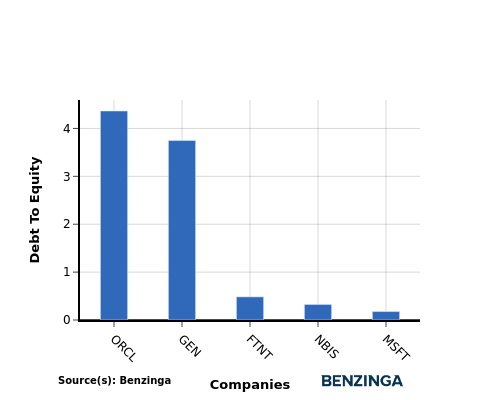Assessing Microsoft's Performance Against Competitors In Software Industry
Author: Benzinga Insights | October 13, 2025 11:00am
In today's rapidly changing and fiercely competitive business landscape, it is essential for investors and industry enthusiasts to thoroughly analyze companies. In this article, we will conduct a comprehensive industry comparison, evaluating Microsoft (NASDAQ:MSFT) against its key competitors in the Software industry. By examining key financial metrics, market position, and growth prospects, we aim to provide valuable insights for investors and shed light on company's performance within the industry.
Microsoft Background
Microsoft develops and licenses consumer and enterprise software. It is known for its Windows operating systems and Office productivity suite. The company is organized into three equally sized broad segments: productivity and business processes (legacy Microsoft Office, cloud-based Office 365, Exchange, SharePoint, Skype, LinkedIn, Dynamics), intelligence cloud (infrastructure- and platform-as-a-service offerings Azure, Windows Server OS, SQL Server), and more personal computing (Windows Client, Xbox, Bing search, display advertising, and Surface laptops, tablets, and desktops).
| Company |
P/E |
P/B |
P/S |
ROE |
EBITDA (in billions) |
Gross Profit (in billions) |
Revenue Growth |
| Microsoft Corp |
37.46 |
11.06 |
13.54 |
8.19% |
$44.43 |
$52.43 |
18.1% |
| Oracle Corp |
67.81 |
34.58 |
14.30 |
13.12% |
$6.12 |
$10.04 |
12.17% |
| ServiceNow Inc |
111.79 |
16.87 |
15.42 |
3.65% |
$0.65 |
$2.49 |
22.38% |
| Palo Alto Networks Inc |
130.34 |
18.04 |
16.04 |
3.37% |
$0.68 |
$1.86 |
15.84% |
| Fortinet Inc |
33.08 |
30.88 |
10.14 |
21.88% |
$0.56 |
$1.32 |
13.64% |
| Nebius Group NV |
168.29 |
8.56 |
117.84 |
16.85% |
$0.61 |
$0.08 |
594.48% |
| Gen Digital Inc |
27.62 |
6.91 |
3.91 |
5.83% |
$0.58 |
$0.99 |
30.26% |
| Monday.Com Ltd |
243.23 |
7.99 |
8.89 |
0.14% |
$-0.01 |
$0.27 |
26.64% |
| UiPath Inc |
568.33 |
5.44 |
6.23 |
0.09% |
$-0.02 |
$0.3 |
14.38% |
| CommVault Systems Inc |
95.13 |
20.76 |
7.32 |
6.81% |
$0.03 |
$0.23 |
25.51% |
| Dolby Laboratories Inc |
25.15 |
2.51 |
4.93 |
1.78% |
$0.07 |
$0.27 |
9.25% |
| Qualys Inc |
25.64 |
9.14 |
7.45 |
9.4% |
$0.06 |
$0.14 |
10.32% |
| BlackBerry Ltd |
112 |
3.65 |
4.97 |
1.83% |
$0.02 |
$0.1 |
2.69% |
| Average |
134.03 |
13.78 |
18.12 |
7.06% |
$0.78 |
$1.51 |
64.8% |
When conducting a detailed analysis of Microsoft, the following trends become clear:
-
With a Price to Earnings ratio of 37.46, which is 0.28x less than the industry average, the stock shows potential for growth at a reasonable price, making it an interesting consideration for market participants.
-
With a Price to Book ratio of 11.06, significantly falling below the industry average by 0.8x, it suggests undervaluation and the possibility of untapped growth prospects.
-
With a relatively low Price to Sales ratio of 13.54, which is 0.75x the industry average, the stock might be considered undervalued based on sales performance.
-
The company has a higher Return on Equity (ROE) of 8.19%, which is 1.13% above the industry average. This suggests efficient use of equity to generate profits and demonstrates profitability and growth potential.
-
Compared to its industry, the company has higher Earnings Before Interest, Taxes, Depreciation, and Amortization (EBITDA) of $44.43 Billion, which is 56.96x above the industry average, indicating stronger profitability and robust cash flow generation.
-
The gross profit of $52.43 Billion is 34.72x above that of its industry, highlighting stronger profitability and higher earnings from its core operations.
-
With a revenue growth of 18.1%, which is much lower than the industry average of 64.8%, the company is experiencing a notable slowdown in sales expansion.
Debt To Equity Ratio

The debt-to-equity (D/E) ratio measures the financial leverage of a company by evaluating its debt relative to its equity.
Considering the debt-to-equity ratio in industry comparisons allows for a concise evaluation of a company's financial health and risk profile, aiding in informed decision-making.
By evaluating Microsoft against its top 4 peers in terms of the Debt-to-Equity ratio, the following observations arise:
-
When comparing the debt-to-equity ratio, Microsoft is in a stronger financial position compared to its top 4 peers.
-
The company has a lower level of debt relative to its equity, indicating a more favorable balance between the two with a lower debt-to-equity ratio of 0.18.
Key Takeaways
For Microsoft in the Software industry, the PE, PB, and PS ratios are all low compared to peers, indicating potential undervaluation. On the other hand, Microsoft's high ROE, EBITDA, and gross profit suggest strong profitability and operational efficiency. However, the low revenue growth rate may raise concerns about future performance compared to industry peers.
This article was generated by Benzinga's automated content engine and reviewed by an editor.
Posted In: MSFT





